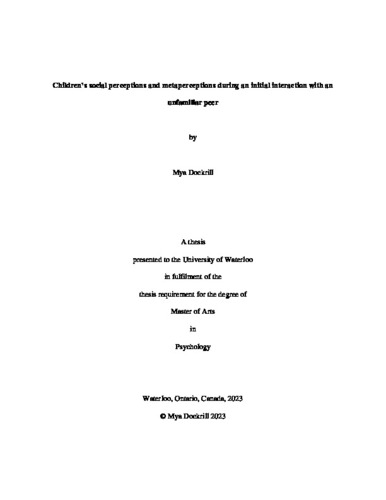| dc.description.abstract | Background. Interacting with an unfamiliar social partner is a critical first step in forming a relationship (Hinde & Stevenson-Hinde, 1987). During these initial interactions, individuals tend to be more positive than negative in their impressions of others (i.e., social perception positivity bias) and tend to think others view them more positively than negatively (i.e., social metaperception positivity bias) (Sears, 1983). Interestingly, though, both children and adults show a “liking gap” where they tend to report liking their social partner more than they think their social partner likes them (Boothby et al., 2018; Wolf et al., 2021). However, research on the “liking gap” in children has mostly used structured tasks such as teamwork activities (e.g., tower-building tasks) to scaffold the interaction (Wolf et al., 2021) as opposed to unstructured tasks such as conversations that are more challenging but more ecologically valid. Further, adults can, in fact, accurately detect the impressions they make on unfamiliar others after a short interaction (i.e., metaperception accuracy) (Carlson & Furr, 2009; Tissera et al., 2023). The goal of the current study was to bring this literature together to examine positivity bias, the liking gap, and metaperception accuracy in children following a brief, unstructured (socially challenging) initial interaction with a previously unfamiliar peer.
Research Aims. Following a five-minute, online, unstructured interaction with a previously unfamiliar peer, I examined a) whether children rate themselves and others more positively than negatively (i.e., positivity bias), b) whether children rate their social partner more positively (and less negatively) than they believe their partner rates them (i.e., liking gap), and c) whether children are accurate in identifying what others think of them (i.e., metaperception accuracy).
Methods. Age- and gender-matched unfamiliar dyads (N = 182, 91 dyads, Mage = 11.50, 79 males) were observed during a five-minute unstructured conversation where children were instructed to ‘get to know each other’ (Usher et al., 2015). Positive and negative social perceptions (e.g., “How happy is [name of partner]?”) and metaperceptions (e.g., “How happy does [name of partner] think you are?”) were assessed with the Perceptions and Metaperceptions Questionnaire (Usher et al., 2018). Means were summed for positive-trait and negative-trait social perceptions, as well as for positive-trait and negative-trait social metaperceptions.
Results. Children gave higher positive than negative trait scores when rating both their social partner and what they thought their social partner rated them (i.e., positivity bias). However, the positivity bias was enhanced when children rated their partner versus when they rated their expectations of how their partner viewed them. When analyzing the data dyadically, results also supported the presence of a liking gap where children believed their social partner was rating them more negatively (and less positively) (i.e., social metaperception) than they rated their social partner (i.e., social perception). Interestingly, children were not accurate in identifying how they were being perceived by their social partner for positive or negative traits and tended to underestimate how positively they were actually viewed by their interaction partner. Instead, children’s metaperceptions (how they believed their partner viewed them) were associated with their own perceptions of their peer.
Conclusion and Implications. Together, these results partially replicate past findings with adults and extend past findings with children (from structured laboratory tasks) to less structured, more socially challenging contexts that better mirror real-world contexts in which friendships develop. These results suggest that children’s initial perceptions, metaperceptions, and their accuracy are more a function of the individual than a function of the dyadic interaction. This research lays the groundwork for future studies examining within-child and interpersonal factors that impact the likelihood of relationship development in late childhood. | en |

